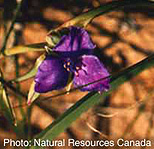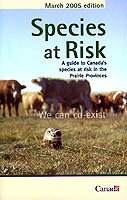
Species at Risk Act (SARA) |
Top |
| The Species At Risk Act covers all listed species on federal lands as well as all aquatic species (anywhere they occur in Canada) and all migratory birds listed in the Migratory Birds Convention Act, 1994 (both on or off federal land). Federal lands include national parks, national wildlife areas, some Prairie Farm Rehabilitation Administration pastures, First Nation reserve lands, and military training areas. |  Western Spiderwort |
The Act requires the development of recovery action plans for species at risk. It also recognizes the essential role of Aboriginal peoples by requiring the establishment of a National Aboriginal Council on Species at Risk. View the Manitoba Wildlands Species Ranking Chart The Minister of Fisheries and Oceans is responsible for aquatic species at risk. The Minister of Canadian Heritage is responsible for all affected species found in national parks, national historic sites and other protected heritage sites. The Minister of the Environment is responsible for all other species at risk and for the administration of the Act. Currently the same minister holds both responsibilities. The Act represents one element of the federal government's strategy for protecting species at risk. The second element is the Accord for the Protection of Species at Risk for the Government of Canada to work with provinces and territories on a common approach to protecting species at risk in Canada (includes complementary provincial legislation and programs to protect habitat and species). The third element is stewardship. Canada's Stewardship Agenda, approved by federal, provincial and territorial Ministers of Wildlife, encourages Canadians to work together in a landscape approach to protect habitat, contribute to the recovery of species at risk and conserve Canada's natural heritage. One such initiative is the federal government's Habitat Stewardship Program for Species at Risk, which funds projects that support habitat conservation and stewardship.  For further information, see the government of Canada's Species At Risk web site
For further information, see the government of Canada's Species At Risk web siteSpring 2005 Environment Canada released its updated regional guides to Species at Risk across Canada. Each species profile includes habitat and range mapping. Manitoba species profiled include: Grey Fox, Woodland Caribou, Wood Bison, Ross's Gull and others in the Species Ranking Chart below. Call the Canadian Wildlife Service in Edmonton, Alberta to request copies (780-951-8700). SARA Public RegistryThe online SARA Public Registry houses information and documents related to the Species at Risk Act (SARA). It is also the forum for the public to submit comments on SARA related documents being developed by the Government of Canada.View the SARA public registry Section 123 of SARA, identifies documents that are required to be published in the Public Registry. Also included are all of the documents specified in various sections of the Act. Documents available in the SARA Public Registry include:
Visit the Advanced Search page for the SARA Public Registry Public Consultations Under SARA - Manitoba SpeciesThe process of adding a species to the official list of species at risk as part of the Species At Risk Act involves public consultation.In fall 2004, Canadians were asked for their input into the decision of whether to add the Lake Winnipeg Physa Snail to Schedule 1 of the Species At Risk Act. The SARA consultation archive can be found on the Species At Risk Act Public Registry web site. The comment period for public input into this decision was from September 27, 2004 - November 15, 2004. Manitoba Wildlands submitted comments in support of adding the Lake Winnipeg Physa Snail to Schedule 1 of SARA as an endangered species.  Download Manitoba Wildlands' Comments - Species At Risk Act Public Consultation - Lake Winnipeg Physa Snail Download Manitoba Wildlands' Comments - Species At Risk Act Public Consultation - Lake Winnipeg Physa SnailENGO Initiatives - Species At RiskEnvironmental organizations in Canada closely monitor government commitments regarding species at risk, and in particular actions under the new SARA legislation. The Sierra Club of Canada (SCC) has issued annual report cards since 1996 on government actions related to international commitments. Commitments regarding biodiversity and species at risk are a significant part of the annual SCC Rio Report. RIO stands for Report on International Obligations, but is also a reference to commitments first made by Canada at the1992 Earth Summit in Rio de Janeiro.
The Sierra Club of Canada (SCC) has issued annual report cards since 1996 on government actions related to international commitments. Commitments regarding biodiversity and species at risk are a significant part of the annual SCC Rio Report. RIO stands for Report on International Obligations, but is also a reference to commitments first made by Canada at the1992 Earth Summit in Rio de Janeiro.Visit the Sierra Club of Canada Endangered Species Campaign web page Visit the Sierra Club of Canada Rio Report web page with links to annual report cards For the past 3 years, Manitoba's Biodiversity grade in the SCC Rio Report has been poor (2002: D-, 2003: D-, 2004: C-). No new species have been added to the Manitoba list under the provincial Endangered Species Act. This is despite COSEWIC, the national scientific entity responsible for evaluating the status of species at risk in Canada and advising governments, assessing Manitoba species as being at risk. The primary example in Manitoba is the woodland caribou. COSEWIC has assessed and listed this species to be threatened in Manitoba. The Manitoba government has not yet included the species in the regulation under the Endangered Species Act and therefore it is not afforded any protection under the law in Manitoba. Certain species, such as cougar, are 'protected' under the Manitoba Wildlife Act. That is, hunting and killing the species is illegal. The Wildlife Act does not include any habitat protection. |
|
 2002-2014
2002-2014

